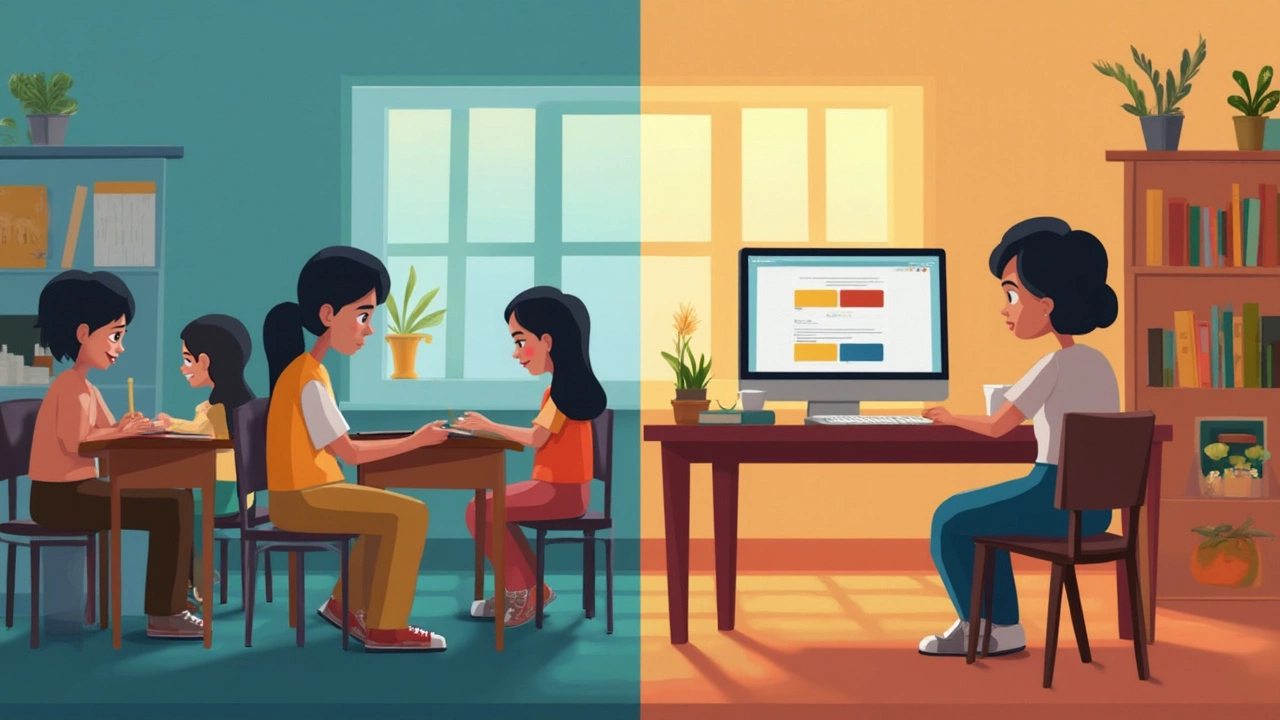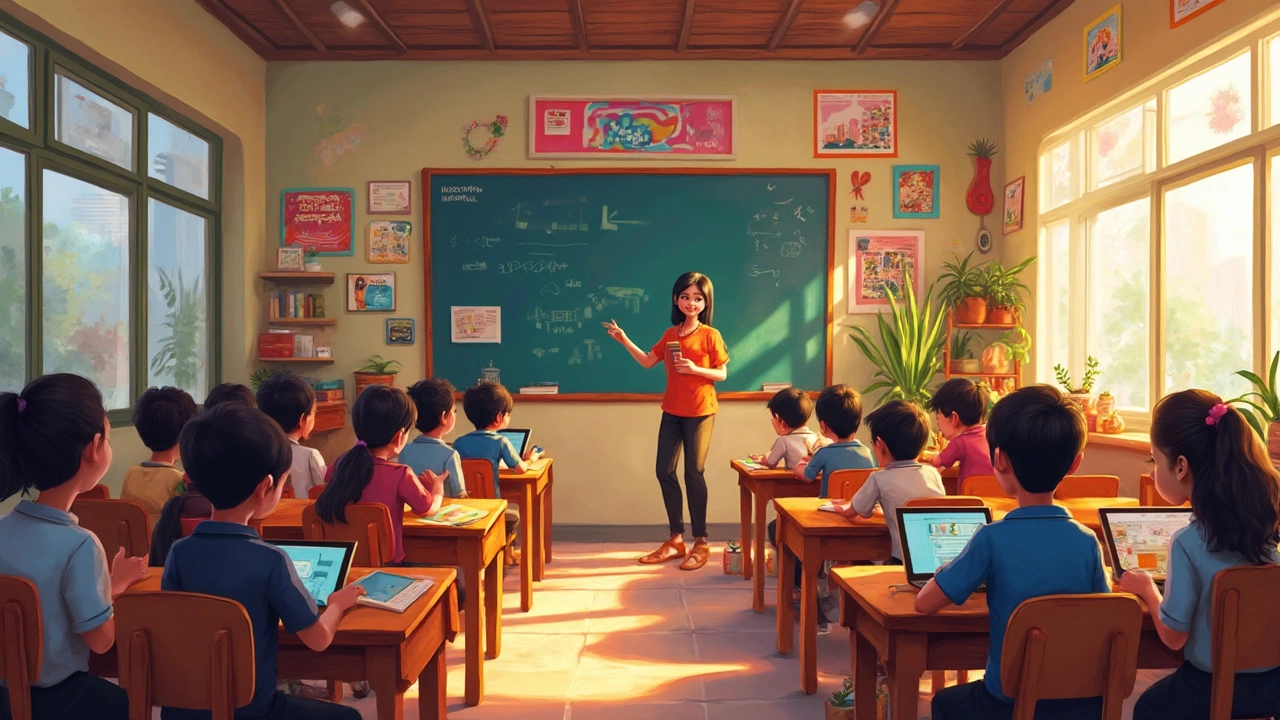So, you're wondering about eLearning and classroom learning, huh? They're like apples and oranges—serving the same purpose but totally different in the way they do it. Let's break it down so it makes sense.
First up, flexibility and convenience. When you're doing eLearning, you've got the freedom to study at 2 AM in your pajamas if you want. Classroom learning? Not so much. You have set times, which works for those who dig a routine. But for some, the digital route means you can juggle job, studies, and life like a pro.
Then there's the whole social side. Classroom learning offers face-to-face chats with teachers and classmates. It's old school, but some folks swear by the energy you get in a room full of people. On the flip side, eLearning platforms often try to mimic this with online forums and video calls. Sure, it's different, but it’s a trade-off for all that convenience.
- Flexibility and Convenience
- Social Interaction
- Teaching Methods
- Cost and Accessibility
- Choosing the Right Fit for You
Flexibility and Convenience
When it comes to eLearning, flexibility is king. Imagine setting your own schedule, picking the time and place that suits your mood—be it a cozy cafe or your living room. That’s the advantage eLearning brings. It's especially golden for those juggling work, family, and education. You just need an internet connection, and you're good to go!
In contrast, classroom learning binds you to a fixed timetable. Classes typically run at a set time in a specific location. While this structure can help some maintain discipline, it might be a hassle for those with unpredictable schedules.
Study at Your Own Pace
eLearning platforms let you cruise through topics or hit the brakes to review tricky parts. Need a refresher on a complex concept? Rewind, rewatch, and learn at your own speed. This 'go-at-your-own-pace' approach can really help with understanding.
The Anytime, Anywhere Element
Here's the beauty of eLearning: it's available 24/7. Got a busy week? Shift your study session to the weekend. For digital nomads or those who travel often, this 'anywhere' aspect is unbeatable.
To give you an idea of how much time you might save, here’s a simple comparison based on commute times and session durations:
| Learning Type | Average Commute/Setup Time | Typical Session Length |
|---|---|---|
| eLearning | 0 mins | Varies - self-paced |
| Classroom Learning | 30-60 mins | Fixed - usually 45-90 mins |
In all fairness, classroom learning does force you out of distractions at home. But if personal convenience tops your list, eLearning is ready for you anytime, anywhere.
Social Interaction
When it comes to social interaction, eLearning and classroom learning serve up completely different experiences. In a traditional classroom, you’re face-to-face with teachers and classmates—no screens, no filters. It’s a vibe that’s been fueling education for centuries. People argue that these interactions help in building social skills and understanding team dynamics.
On the other hand, eLearning tries to bridge the gap with online forums, discussion boards, and live video sessions. While it might lack that physical presence, it makes up with global accessibility. Imagine interfacing with people halfway across the globe, right from your couch!
Real-time Feedback
In a classroom, you raise your hand, get an answer—just like that. This immediate feedback can be essential for some learners. eLearning platforms usually have emails or chat systems, which might take a bit longer but offer the advantage of well-thought-out responses.
Networking Opportunities
Classrooms naturally create a network. Think study groups, campus events, and post-class coffee breaks. These opportunities can be crucial for future collaborations or job referrals. Meanwhile, eLearning provides a digital space to network. You meet folks with similar interests from all over, giving your professional circle a global spin.
Interestingly, a 2022 study found that around 75% of eLearners felt satisfied with their online interaction compared to traditional methods. Surprising, right? It seems like eLearning isn't all loners behind screens after all!

Teaching Methods
When it comes to teaching methods, there's a noticeable shift between eLearning and classroom learning. Dive into the world of classroom learning, and you'll find a structured environment with lessons delivered in person. Teachers often rely on lectures, group discussions, and hands-on activities. It's interactive in a face-to-face way.
In eLearning, the landscape is different but no less effective. Here, technology takes center stage. Lessons are often multimedia-rich with videos, interactive quizzes, and even simulations. Ever tried a virtual lab? That's the kind of cool stuff you might encounter in the digital learning realm.
Personalization and Pacing
One strength of eLearning is the ability to personalize the pace. You get to control the speed—pause when you need to digest something or rewatch a video until it clicks—and that can be a total game-changer for some students. In a traditional classroom, there's a set pace that everyone has to keep up with.
Engagement Techniques
Engaging students is crucial in any teaching method. Classroom learning relies on eye contact, tone of voice, and the occasional spontaneous discussion to keep attention. In eLearning, educators use forums, live webinars, and interactive content to maintain engagement. Each method has its strengths; one might suit you better than the other depending on how you learn best.
Here's a quick comparison to sum up:
| Aspect | Classroom Learning | eLearning |
|---|---|---|
| Interaction | Direct and personal | Digital and flexible |
| Resources | Physical materials | Digital content |
| Pacing | Teacher-led | Student-controlled |
| Engagement | In-person dynamics | Interactive media |
So, whether you're a hands-on type or someone who thrives with a bit of tech, both teaching methods bring something valuable to the table. It's all about finding the right mix that suits your learning style.
Cost and Accessibility
Alright, let's talk about the moolah involved in eLearning versus classroom learning and how accessible these options truly are. You've probably heard that eLearning is cheaper, right? Well, that's pretty spot on. Online courses often save you costs on commuting and physical materials since textbooks are mostly digital.
On the flip side, classroom learning comes with added expenses like travel, housing (if you're attending an out-of-town institution), and sometimes hefty tuition fees. However, some folks argue it's worth it for the campus experience. But when cash is tight, eLearning platforms might seem more appealing. Plus, many online courses offer flexible payment plans or pay-per-module schemes, easing the burden on your wallet.
Accessibility
Now, about accessibility—it's a game-changer. With the digital world, you’re not limited by geography. No matter where you live, you can access a course from halfway across the globe. All you need is a decent internet connection and a device. This opens up opportunities for people in remote areas or those unable to move for education.
Classroom learning might offer more resources on-site, but getting there can be a hurdle. This includes people with disabilities, those who don't have good local options, and working professionals who can't easily adjust their schedule to attend classes in-person.
Additional Pointers
- Some eLearning platforms offer free or cheaper versions of courses, so scout around for those hidden gems.
- Keep an eye out for scholarships or financial aid in both classrooms and online settings—they can significantly cut down your costs.
Here's a quick glance at average costs for both methods:
| Learning Method | Average Cost per Year |
|---|---|
| eLearning | $1,500 - $3,500 |
| Classroom Learning | $5,000 - $20,000 |
Keep in mind, these are rough estimates and can vary based on factors like location and the institution's prestige. But it gives a fair snapshot of what to expect.

Choosing the Right Fit for You
Deciding between eLearning and classroom learning isn't a one-size-fits-all kind of deal. It's more personal, like picking out a new pair of shoes. You need what works for your lifestyle, learning style, and even your social needs.
Learning Style
Think about how you learn best. Are you into self-paced study where you can rewind videos or re-read articles? If so, eLearning might be your jam. But if you're all about group discussions and real-time feedback, classroom learning could be the way to go.
Time Management
Got a packed schedule? eLearning lets you squeeze in education between work shifts or while the kids nap. On the flip side, classroom settings provide structure and routine, which is great if you're prone to procrastination.
Cost Factor
Money talks, right? Generally, eLearning tends to be easier on the wallet since you cut out travel costs and often get cheaper course fees. But classroom courses might offer resources, like labs or studios, that you can’t get online.
Social Needs
Are you a social butterfly? Then classroom settings offer that interaction. But if you’re comfortable engaging through forums or video calls, eLearning won't leave you feeling isolated.
The Bottom Line
At the end of the day, it’s about finding what clicks for you. Maybe even mix it up—use both eLearning and classroom learning to get the best of both worlds.
| Mode | Flexibility | Interaction | Cost |
|---|---|---|---|
| eLearning | High | Moderate | Lower |
| Classroom Learning | Low | High | Higher |

